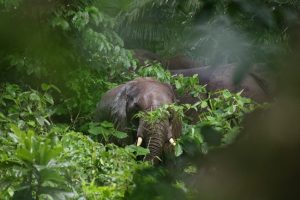I believe in the power of collaboration, innovation, and commitment to make a positive change to our world. The visit I made to Chebera Churchura National Park, in my home-country Ethiopia, in late October 2023, was of special significance to me, a chance to see my beliefs translated into action, with both people and elephants likely to benefit.

Chebera is a jewel of forested hills and mountains in southwestern Ethiopia. It is home to approximately 400-600 elephants, believed to now be the largest population in Ethiopia’s sadly diminished total of c 1500-2,000. These elephants have been coming into increasing conflict with local communities in the surrounding farmlands, where they regularly destroy and consume crops such as maize, sorghum and bananas.
I have been visiting Chebera for almost a decade, and have watched with dismay as villagers, some who have become close friends, suffer emotionally and financially as a result of the ruined harvests, deaths and injuries of loved ones inflicted by marauding elephants and buffalos. People feel betrayed.
One farmer, Yeshak Abraham, told us recently, “For years, people have come and said our lives would change, that people would come to pay and see elephants and we would be compensated for the many centuries we have tolerated and coexisted with them. But now we see that those who come do not see us, they only see the elephants and then they leave. We are left to deal with our poverty and challenges on our own.”
But this latest visit was to celebrate a more hopeful initiative, one we have long worked to realise; the inauguration of three community watchtowers. These are the first in Ethiopia and they signal a more proactive approach to mitigating human-elephant conflict (HEC). The watchtowers were funded by the Elephant Crisis Fund (ECF) and their construction was managed by the Elephant Protection Initiative Foundation (EPIF), local communities, and the Ethiopian Wildlife Conservation Authority (EWCA), working together to overcome endless bureaucratic hurdles. I see them as a beacon of hope at a time when my country faces a multitude of challenges; the impacts of armed conflict and covid, on-going ethnic divisions, economic recession, insecurity, and inflation.
These metal watchtowers, strategically positioned in Seri and Yora villages, are approximately 7 metres tall. They give villagers an early warning system to notify families, including mothers with young children, to remain indoors; the scouts who use them will know when wildlife is approaching the crops, and using torches and loud noises, they will be able to scare wildlife away.
They are “the eyes of the community” and they ought to reduce the risk of dangerous encounters between people and elephants, especially during the critical harvest period. This process will help rebuild trust; these towers show long-abandoned communities that their struggles matter and are noticed by the outside world.

The inauguration event, which took place on October 23 and 24, 2023, brought together key stakeholders, including the EWCA, Chebera park officials, and representatives from the Southern Nations authorities. The Chebera Churchura NP Warden, Teshale Imeta, the Director General of EWCA, Kumara Wakjira, and the regional tourism leader, Fantahun Blate, all commended the project’s progress. Despite the challenges, we had adhered to timelines and budgets.
The journey is far from over. At the EPIF one of our strategies in managing HEC is to bring together rural communities with the decision-makers who are often removed from the realities of the frontline. We are adopting a comprehensive approach to address HEC and empower those who suffer from it. At Chebera we have also distributed shovels and wheelbarrows, as well as high-powered torches. Elephants use the smell of their dung as a ‘marking’ technique to guide them back to their favourite crops; now the farmers can move the dung to stop it being used in this way, (it also makes for useful compost elsewhere!).
The watchtowers represent hope, but they only be effective if they are consistently staffed and supported in the coming months and years. One community leader in Seri said. “We must ensure that the park managers are able to help us use the watchtowers 24/7 so we never lose a family member or our crops again.” We want to ensure that the impact of the watchtowers continues to be monitored, studied and documented. We see them as symbols; of the need to protect both communities and wildlife equally, to reconcile competing priorities and land-use planning, and to alleviate poverty and insecurity.
Ethiopia is Africa’s second most populous nation, with more than 120 million people. Can we share this landscape with our few surviving elephants? It ought to be possible. In Chebera the issues are complicated, and some groups are looking to profit from land use in ways that are not conducive to local interests or conservation. We are taking things one step at a time, but we are at least trying to forge a future where humans and elephants can thrive together in harmony, as they have for time immemorial.
By Greta Francesca Iori
